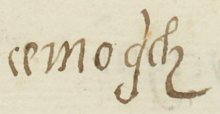Cemoquich (MH638r)
This black-line drawing of the compound glyph for the personal name Cemoquich (perhaps “An Only Man” or "A Lone Man") is attested here as a man’s name. It shows the small head of a man (oquichtli) in profile, facing toward the viewer's right. His eye and mouth are open. In front of his face is an egg-shaped oval with hatching or a mesh design. The oval is as large or larger than the man's head. The oval may be intended as a numerical notation for one (ce) or it may be meant to indicate an ear of corn (centli, also spelled as cintli), providing the phonetic element for the start of the name (Cem-). Given that the man's mouth is open, about to bite the object in front of him, the reading of cintli/centli is most convincing.
Stephanie Wood
The glyph for the personal name Cemolotl is reminiscent of the one here. Cemolotl was a way of saying "one" (given that olotl was a counter in the numbering system). Of course, olotl also refers to one maize cob after the kernels were removed, yet in both glyphs there are indeed indications of kernels (whether through cross-hatching or segmentation). Given the centrality of these corn cobs to daily life for the Nahuas, it is no wonder that they could be useful as counters.
Stephanie Wood
cemoq~ch
Cemoquich
Stephanie Wood
1560
Jeff Haskett-Wood
maize, maíz, hombres solos, género, nombres de hombres

cemoquich(tli), an only man, https://nahuatl.wired-humanities.org/content/cemoquichtli
ce, one, https://nahuatl.wired-humanities.org/content/ce
cin(tli), dried ear of maize, https://nahuatl.wired-humanities.org/content/cintli
oquich(tli), a man, https://nahuatl.wired-humanities.org/content/oquichtli
Hombre Solo
Stephanie Wood
Matrícula de Huexotzinco, folio 638r, World Digital Library, https://www.loc.gov/resource/gdcwdl.wdl_15282/?sp=358st=image.
This manuscript is hosted by the Library of Congress and the World Digital Library; used here with the Creative Commons, “Attribution-NonCommercial-ShareAlike 3.0 License” (CC-BY-NC-SAq 3.0).





